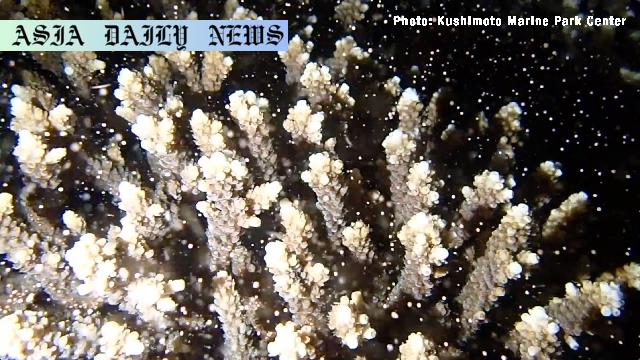Coral Spawning: Acropora Muricata Begins Mesmerizing Process Off Kushimoto Town, Wakayama Prefecture
A specific staghorn coral species has begun its annual spawning off Wakayama Prefecture.
Captured near Kushimoto Town, this natural phenomenon is associated with the warm Kuroshio Current.
Aquarium staff member Sakuma Yuumi expresses awe at the spectacular yearly event.
Other varieties of coral, such as acropora spicifera, are expected to spawn next month.

Coral Spawning: A Fascinating Natural Event
Each year, the waters off Kushimoto Town in Wakayama Prefecture, Japan, become the scene of an incredible natural event—coral spawning. This year is no exception, as the staghorn coral species (acropora muricata) has begun releasing its pale-pink reproductive bundles into the warm Pacific Ocean. These ‘bundles,’ approximately one millimeter in size, contain eggs and sperm, essential to the coral’s lifecycle. This spawning phenomenon is believed to be closely linked to environmental factors such as water temperature, moon phases, and the seasonal currents of the Kuroshio Current.
Wakayama’s proximity to the Kuroshio Current makes it a haven for various coral species, including staghorn coral and the table coral species known as acropora spicifera. The Kuroshio Current, known for its nutrient-rich, warm waters, plays a pivotal role in sustaining these coral ecosystems. The spawning event marks a critical period in the coral lifecycle, ensuring the propagation and genetic diversity of these marine organisms.
A Rare and Beautiful Event Observed By Experts
Sakuma Yuumi, a staff member of a local aquarium, captured stunning footage of the spawning event late on a Saturday night. She noted her continued amazement at witnessing this annual event, calling it an awe-inspiring and remarkable display of nature’s brilliance. For Sakuma and her fellow marine enthusiasts, this yearly phenomenon serves as a stark reminder of the interconnectivity and fragility of marine ecosystems.
The fascinating scene also highlights the broader environmental significance of coral reefs. As one of the most biodiverse marine habitats on earth, coral reefs are a lifeline for countless marine species. The spawning process showcases the resilience of these ecosystems, but it also underlines their dependence on stable environmental conditions.
Looking Forward: Table Coral Spawning Next Month
The excitement doesn’t end with the recent staghorn coral spawning. Another species, the acropora spicifera, or table coral, is set to spawn early next month. This prolongs the period of observation and research for marine scientists and enthusiasts. Known for forming expansive horizontal coral structures, table corals play a significant role in providing nurturing grounds for various marine species. Observing their spawning behavior is key to understanding their reproductive patterns and the conditions they require.
Scientific documentation and footage of these spawning events are pivotal for raising awareness about marine conservation efforts. Efforts to preserve coral habitats have grown in relevance as climate change poses greater risks to these delicate ecosystems. Warming oceans, coral bleaching, and water pollution have had devastating impacts on reefs worldwide, making annual spawning events like this a powerful symbol of hope and renewal.
Protecting Coral Reefs: Conservation Initiatives
Coral reefs serve as a natural barrier against coastal erosion, provide essential sustenance to marine life, and contribute significantly to global marine biodiversity. It is essential, however, to prioritize efforts to protect their natural habitats. Scientists and conservationists alike emphasize the need for international cooperation to combat climate change, reduce marine pollution, and institute sustainable fishing practices.
Programs to restore degraded coral reefs and initiatives that educate the public about their importance are becoming increasingly crucial. Community-based participation and governmental action can make a consequential difference in ensuring that coral spawning events, such as those observed in Wakayama, continue to thrive.
Commentary
The Spectacle of Coral Spawning
The annual spawning of coral in the waters off Wakayama Prefecture is nothing short of magical. As I read about the staghorn coral’s pale-pink bundles taking to the ocean currents, I am left in awe of nature’s meticulous cycles. These moments, brief yet transformative, highlight the delicate interplay between marine organisms and their environment. Witnessing these events must be a profound reminder of the world’s intricate connections, something we often overlook in our busy lives.
Nature’s Resilience and Fragility
What strikes me most is the resilience of coral ecosystems. Coral reefs, despite facing relentless challenges from climate change and human-induced stressors, continue their annual rituals, holding onto life as tenaciously as possible. However, this resilience should not be mistaken for invincibility. Coral bleaching and marine pollution are stark reminders of how precarious these ecosystems have become. I find it imperative for governments and environmental communities to amplify their efforts in protecting these habitats. The fact that coral spawning is considered a rare, awe-inspiring spectacle underscores its vulnerability and necessity to preserve.
Inspirations from Observing Nature
I am deeply inspired by people like Sakuma Yuumi, who dedicate their time and passion to observing natural phenomena. Their work ensures that we continue to appreciate and understand the magic of ecosystems like coral reefs. Through her camera lens, she not only documents a wondrous event but also tells a story of life’s tenacity and beauty. Her appreciation for the undersea world serves as a call for all of us to deepen our respect and concern for our planet.
Events like coral spawning remind us of the unparalleled beauty of nature. As we continue to face pressing environmental challenges, I hope stories of resilience, like that of the coral reefs in Wakayama, fuel a collective resolve to protect our natural world.


